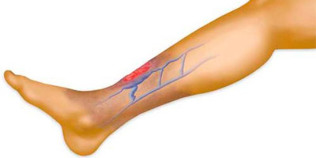Know about the stages of varicose veins it is very important that the time to begin prevention and treatment. After all, it may be the first step to maintaining the health of the veins. Such feelings as fatigue and weight in the feet by the end of the day, known to almost everyone, but a few of them that communicate with the varicose veins. In the meantime, these symptoms can be signs of vein disease.
Just keep in mind that there are several variants of classification of stages of varicose veins of the legs. It refers to that which divides the disease into three phases: compensation phase, stage of the subcompensation phase of decompensation. Take a closer look.
Varicose veins: initial phase
The initial stage of varicose veins, also called the compensation stage.
This period can last from several months to several years. The fact that the body's inherent mechanisms which are activated when a defect of the veins, and compensate for them. It is the reason why the initial stage of varicose veins is called "phase compensation." But, in this lies the danger: the man can a long time to ignore the signs and miss the time when the fight with him will be very effective.

In this phase, the external signs of varicose veins may be absent, and can appear as spider veins - the harbingers of varicose veins. Patients suffer from heavy legs, bloating, swelling of the feet towards evening, but they carry a slight discomfort. Usually, these symptoms are written off to fatigue at the end of the day, especially if the profession is associated with prolonged stay on his feet.
If varicose veins are diagnosed at an early stage, there will be a conservative non-surgical treatment. In particular, there are different types of sclerotherapy.
Varicose veins progresses
Looks like varicose veins in the early stage of the approximately clear: foreign characters are not expressed, the patient should focus on their health. But, in the second stage, called the stage of decompensation, patients typically seek medical assistance.
Under-compensation stage of the disease when the body cannot fully cope with all the negative consequences. The patient begins not only to complain of pain or swelling at the end of a hard day, but was in constant discomfort, which prevents him from leading a normal life. And in this time has the right to appeal to phlebologist is a must.
Veins in this stage are becoming more pronounced and clearly visible. The skin may become darker, blue color. At this stage discomfort that the patient identified in the initial stage of varicose veins, to increase. Swelling, pain, burning sensation, slight cramps in the legs it is noted not only in the evening and in the night.
In this phase, indicates a more serious treatment: laser coagulation, minimally invasive surgery, definitely recommend wearing compression hosiery.
If the veins are not treated...
If patients do not apply closely to his condition and may not be appealed to phlebologist, varicose disease passes into the third de-compensatory stage.
Decompensation - the stage of the disease when the body can not cope with its function as a result of prolonged illness. At this point, the adaptation mechanisms and the devices stop working.
De-compensatory stage of varicose veins blood flow in veins is disturbed severely deformed. Suffering as a result of it, the nutrition of the tissues, they accumulate fluid, you may experience the sores. The veins are strongly deformed, it is possible serious complications in the form of thrombophlebitis.

At this stage the treatment of varicose veins is necessary to perform urgently, conservative methods have proven ineffective, so patients are shown surgery. Otherwise, the disease begins to endanger life.
There is an international classification of varicose veins, which is different from the above. Experts identify seven stages of the disease, which is denoted by the letter C (in Latin class):
- S0 is the stage where the visible signs of varicose veins do not exist
- S1 - the appearance of a spider or reticular veins (small, superficial) veins
- C2 - become visible subcutaneous veins with diameter larger than 3 mm
- C3 - stage of the varicose veins, which are characterized by constant swelling
- S4 - the appearance of skin changes or venous ulcers
- C5 - establishment of a closed venous ulcers
- S6 - formation of open venous ulcers
And remember: regardless of the classification stages of the expanding concerns of the treating physician, the treatment is most effective in the early stages.




































